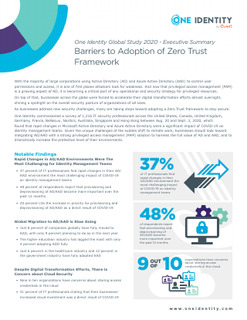Barriers to Adoption of Zero Trust Framework
With the majority of large corporations using Active Directory (AD) and Azure Active Directory (AAD) to control user permissions and access, it is one of first places attackers look for weakness. And now that privileged access management (PAM) is a growing aspect of AD, it is becoming a critical part of any operational and security strategy for privileged resources.
On top of that, businesses across the globe were forced to accelerate their digital transformation efforts almost overnight, shining a spotlight on the overall security posture of organizations of all sizes.
As businesses address new security challenges, many are taking steps toward adopting a Zero Trust framework to stay secure.
One Identity commissioned a survey of 1,216 IT security professionals across the United States, Canada, United Kingdom, Germany, France, BeNeLux, Nordics, Australia, Singapore and Hong Kong between Aug. 20 and Sept. 3, 2020, which found that rapid changes in Microsoft Active Directory and Azure Active Directory were a significant impact of COVID-19 on identity management teams. Given the unique challenges of the sudden shift to remote work, businesses should look toward integrating AD/AAD with a strong privileged access management (PAM) solution to harness the full value of AD and AAD, and to dramatically increase the protection level of their environments.

